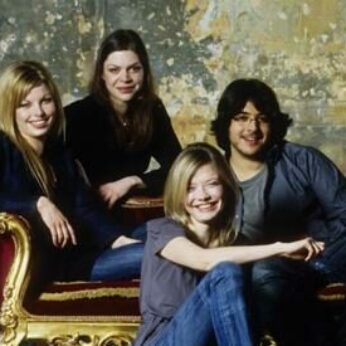Composer: Wolfgang Amadeus Mozart (b. 1756 - d. 1791)
Performance date: 01/07/2010
Venue: St. Brendan’s Church
Composition Year: 1785
Duration: 00:33:16
Recording Engineer: Anton Timoney, RTÉ lyric fm
Instrumentation: 2vn, va, vc
Instrumentation Category:String Quartet
Artists:
Chiaroscuro Quartet (Alina Ibragimova, Pablo Hernán Benedí [violins], Emilie Hörnlund [viola], Claire Thirion [cello]) -
[quartet]

The
A major Quartet is the fifth in Mozart’s set of six quartets
dedicated to his great friend Joseph Haydn and it was written at the
time of Mozart’s greatest triumphs, when his name was on every lip
due to the spectacular success of his subscription concerts.
The
friendship between the two composers is one the great stories of
musical history, matched only by that of Brahms and Schumann.
Mozart’s determination to impress Haydn and to win his respect is
nowhere more apparent than on the manuscript scores for these
quartets, nowhere else are there so many corrections strewn above
crossed-out tempi and dynamic markings. And the evening when the two
composers sat down together to play through the last three quartets
in the set with Haydn playing first violin and Mozart viola speaks
worlds about their mutual understanding of each other’s
achievement.
The
most obvious difference between the two sets is that Mozart’s are
easily twice as long and the increased scale indicates a much greater
ambition for this new chamber music combination. Out of the older
composer’s invention the younger one created a new world, which was
itself to inspire the next in the succession. Beethoven’s A major
Quartet in his Opus 18 set is clearly composed as a homage to
Mozart’s A major.
Mozart’s
opening movement is built on the briefest of material, more questions
and answers than fully formed themes. The first subject, for
instance, consists of a query put by the first violin and a vigorous
unison reply; the second subject is even less substantial, three
rising notes and a graceful run of triplets. The exposition closes
with a restatement of the opening before we are launched into the
complex many voiced development based entirely on the questioning
figure and its answer. The recapitulation is straightforward and the
movement ends uneventfully.
The
minuet is based on another terse phrase, almost as if asking what is
the question for this answer. The questioning figure gets tossed
hither and thither in many different voices, some harsh, some gentle.
The Trio is more euphonic though the desire to embellish and decorate
soon takes over.
The
D major Andante
is
a theme with six variations and a coda. The theme is quiet and
reflective, the kind of beauty that succeeds by understatement in
abrupt contrast to the florid embellishments of the first variation.
The second one takes a completely new path, establishing a secondary
theme to be explored in the drum-beat sixth variation. The third
variation plunges into an aura of mystery led by Mozart’s viola
before we are dragged even further afield into dramatic and gloomy D
minor. The fifth variation retains the air of uncertainty before all
is made clear with the extraordinary drum taps of the sixth, which
continue right into the coda where each instrument gets to hold the
drumsticks, though the cello gets the most fun.
The
surprises are not over yet for this is the movement that Beethoven
relished. It is ostensibly in sonata form though you would be
forgiven if you thought it was an endless imitative hot pursuit of
the opening ideas, until the sudden intrusion in the middle of the
development of a lofty chorale in D major, which also returns in the
recapitulation. The coda picks up on Haydn’s practice of joke
endings to give a witty and enigmatic close.
Copyright © 2025 West Cork Music. All rights reserved.
Designed and developed by Matrix Internet